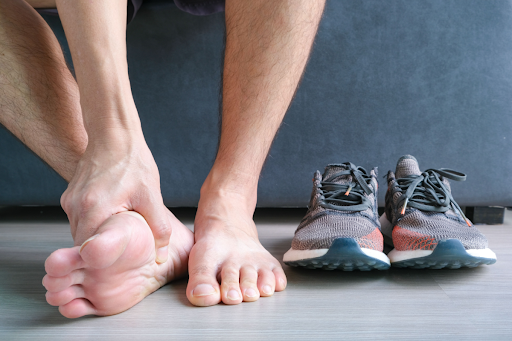Plantar Fasciitis vs. Heel Spurs: What’s Causing Heel Pain?
Is heel pain in the morning, stiffness when walking, or discomfort that lingers throughout the day sound familiar? That persistent ache might come from plantar fasciitis, an inflammation of the thick tissue band stretching from your heel to your toes. The fascia absorbs shock and supports your arch but can develop micro tears when overworked, triggering pain and stiffness. It could also be caused by heel spurs, the bony growth on the underside of your heel that can become painful over time. Knowing which condition is the cause of your heel pain dictates exactly what kind of treatment makes the most sense for you. One Oak Medical works closely with our patients to identify what exactly is wrong with their heels and determine the best course of action for their long-term health.
What Is Plantar Fasciitis?
If you’re feeling a persistent ache in your heels, it might come from plantar fasciitis, an inflammation of the thick band of connective tissue that stretches from your heel to your toes. The plantar fascia functions like a shock absorber, stabilizing the arch and aiding movement. However, when this fascia endures excessive stress, it develops microtears, triggering pain, inflammation, and stiffness.
Plantar fasciitis doesn’t happen overnight. It develops gradually due to repetitive strain, improper footwear, weight gain, or high-impact activities like running. The pain often worsens with prolonged standing, sudden movement, or improper gait mechanics. If plantar fasciitis is left untreated, it can limit mobility and impact quality of life.
Symptoms of Plantar Fasciitis
Plantar fasciitis manifests in several ways, but one of the most common symptoms is sharp pain at the base of the heel. That first step out of bed in the morning? It often feels like stepping on a nail, a sudden jolt of discomfort that eases as you move but never fully disappears. The pain flares up after long periods of rest, intensifying along the sole of the foot. Walking barefoot on hard surfaces, climbing stairs, or engaging in high-impact activities only exacerbates the problem. Symptoms of plantar fasciitis include:
- Heel pain in the morning: A stabbing sensation upon taking the first steps of the day.
- Pain that worsens with activity: Running, jumping, or prolonged standing increases discomfort.
- Stiffness and swelling: The heel and arch may feel tight or inflamed, especially after rest.
- Tenderness along the plantar fascia: Pressing on the heel or arch can trigger pain.
- Pain that improves with movement but returns later: Symptoms often lessen with activity but flare up after prolonged exertion.
Without proper treatment — whether through stretching exercises, physical therapy, or orthotic shoe inserts — plantar fasciitis can become chronic pain that disrupts daily life. Addressing symptoms early helps reduce long-term complications and restore mobility.
What Are Heel Spurs?
Heel spurs, also called calcaneal spurs, are bony growths that develop on the underside of the heel bone (calcaneus). They form when calcium deposits build up over time, typically due to chronic strain on the plantar fascia. Unlike plantar fasciitis, which inflames soft tissue, heel spurs are physical outgrowths of bone that can create long-term discomfort.
While some people develop heel spurs without symptoms, others experience sharp, stabbing pain when pressure lands on the affected area. Walking, running, and even standing for extended periods can become unbearable. Risk factors include excessive weight, poor foot mechanics, frequent high-impact activities, and ill-fitting footwear.
Symptoms of Heel Spurs
Heel spur pain doesn’t always make itself known right away. Many patients live with calcaneal spurs without symptoms, but when discomfort strikes, it often feels like a sharp, stabbing sensation in the heel, especially when standing or walking after a long rest. Unlike plantar fasciitis, heel spur pain persists even after movement begins. Symptoms of heel spurs include:
- Persistent heel pain: A sharp or aching pain at the base of the heel that doesn’t subside with movement.
- Increased discomfort after activity: Running, jumping, or prolonged standing can worsen pain.
- Swelling and tenderness: The affected area may feel inflamed, making wearing tight or unsupportive shoes difficult.
- Pain when pressing on the heel: Direct pressure can trigger localized discomfort.
- A feeling of stepping on a rock: Some patients describe a sensation like having a pebble inside their shoe.
Heel spur treatments often involve a combination of physical therapy, supportive footwear, anti-inflammatory medication, and, in severe cases, minimally invasive procedures like corticosteroid injections or shock wave therapy. A proper diagnosis through imaging tests, such as X-rays, can help determine the best course of treatment and long-term pain management.
How to Tell the Difference Between Plantar Fasciitis & Heel Spurs?
While both conditions cause heel pain, the primary difference lies in the source and pattern of that pain. Plantar fasciitis is a soft tissue issue rooted in inflammation and strain on the plantar fascia. It hurts most in the morning or after prolonged inactivity but eases up with movement. On the other hand, heel spurs stem from excess calcium buildup on the heel bone, leading to persistent pain regardless of activity levels.
A spur might be the culprit if pressing on the heel bone triggers discomfort. If pain diminishes as you walk but returns with prolonged standing, plantar fasciitis could be the underlying cause. While you can try to self-diagnose your problem, the best way to A physical examination, imaging, and patient history help our physicians properly diagnose the condition and give us the insight necessary to treat you. However, both can develop simultaneously, complicating diagnosis and treatment.
What Are the Treatment Options?
Plantar fasciitis treatment and heel spur treatments range from conservative approaches to surgical interventions. Conservative options include ice packs, stretching exercises, foot massage, and anti-inflammatory medications like nonsteroidal drugs may provide some relief. Shock wave therapy, casting, and corticosteroid injections help alleviate pain and inflammation for many patients. In extreme cases, a surgical option is available to help you deal with your plantar fasciitis. On the other hand, heel spurs are rarely treated with surgery. In most cases, a heel spur on its own won’t cause you physical pain. However, the conditions contributing to your pain should be addressed.
Orthotic shoe inserts and supportive footwear relieve pressure on the heel and fascia. Physical therapy strengthens foot and calf muscles, improving flexibility and function. For severe cases, minimally invasive procedures like fasciotomy or percutaneous treatments may be necessary. If conservative methods fail, orthopedic surgery becomes an option, removing spurs or releasing tight connective tissue.
Weight management plays a critical role in reducing heel pain. Excess weight increases stress on the foot, worsening inflammation and pain. Strength training, diet adjustments, and low-impact exercises like swimming or cycling help reduce strain on the fascia and heel bone.
Finding the right combination of therapy, footwear, and medical care is key to long-term relief. One Oak Medical has the experience and proven track record of helping our patients identify and treat these conditions and giving them the improved quality of life they deserve.
Schedule Your Next Consultation With One Oak Medical Today
Heel pain shouldn’t define your day. Whether it’s plantar fasciitis, a calcaneal spur, or another foot-related issue, relief starts with expert evaluation. One Oak Medical provides comprehensive care, from conservative treatments to advanced procedures, to get you back on your feet.
Take control of your foot health with One Oak Medical. We’ll conduct a thorough physical examination, medical history review, and imaging tests to pinpoint the exact cause of your pain. Don’t let discomfort keep you from walking, running, or living life to the fullest. Contact our team to schedule an evaluation and explore the best treatment plan for your needs.

